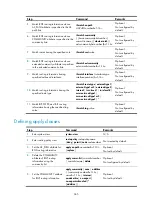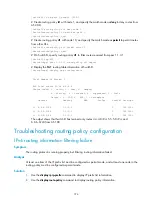
359
Configuring routing policies
Hardware compatibility
The A5500 SI Switch Series does not support OSPF, BGP, IS-IS, OSPFv3, IPv6 BGP, IPv6 IS-IS, or FRR.
Introduction to routing policy
Routing policies are used to receive, advertise, and redistribute only specific routes and modify the
attributes of some routes.
Routing policy in this chapter involves both IPv4 routing policy and IPv6 routing policy.
A routing policy is used to filter routes when they are received, advertised, or redistributed and modify
the attributes of some routes.
Routing policy application
A routing policy has the following applications:
•
Filters advertised routes.
•
Filters received routes.
•
Filters redistributed routes.
•
Modifies or sets the attributes of some routes.
Routing policy implementation
To configure a routing policy, you must do the following:
1.
Define some filters based on the attributes of routing information, such as destination address, and
the advertising router's address.
2.
Apply the filters to the routing policy.
You can use multiple filters to define match criteria. For more information, see "
."
Filters
You can use the following types of filters: ACL, IP prefix list, AS path list, community list, extended
community list, and routing policy.
ACL
ACL involves IPv4 ACL and IPv6 ACL. An ACL is configured to match the destinations or next hops of
routing information.
For more information about ACL, see
ACL and QoS Configuration Guide
.
IP prefix list
IP prefix list involves IPv4 prefix list and IPv6 prefix list.
















































